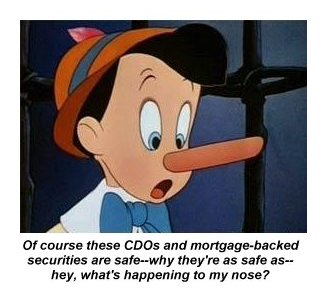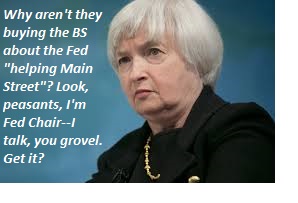by Bill Bonner
The Bad Analogy Debtberg
Last week, McKinsey Global Institute reported that the world’s total debt levels were twice what we thought – $200 trillion, or about three times the planet’s total output.
So, what a relief it was to discover… only a few hours later… that there was nothing whatsoever to worry about. Our concern was totally misplaced. It was nothing but a colossal misunderstanding or, as Nobel laureate economist Paul Krugman put it in the New York Times, a “bad analogy.”
So now, we can go back to our Portuguese lessons here in São Paolo without a care.

Growth in global debt, per the latest McKinsey report on the non-deleveraging echo bubble era: Since Q4 2007, global debt levels have increased by a cool $57 trillion. Thankfully, Paul Krugman informs us that it “doesn’t matter”. Phew! Dodged a bullet there! – click to enlarge.
Mastering the Essentials
Are you curious about how much progress we are making in Portuguese? We didn’t think so. But we’ll tell you anyway. We pride ourselves on our ability to learn foreign languages quickly. Put us down in any city in the world… and after three days of intensive language lessons we’ll be able to walk into any bar in the city and order a beer. With confidence.
So it is in São Paulo. We can’t conjugate the verb conhecer yet. We can’t pronounce it either. But we have mastered the essentials – “please,” “thank you” and “debt bomb.”
Only now there’s no further need to think about debt. Especially here in Brazil. Even after 13 years of socialist government, public debt is only 60% of GDP. According to World Bank data, private credit was 70% of GDP as of the end of 2013 – or barely a third of America’s 192% level.
Of course, Brazil used to be a basket case of epic proportions. At the start of 1980, for example, a hamburger cost about 4 cruzeiros (the Brazilian currency from 1942 to 1986). The same hamburger cost about 5 trillion cruzeiros by Christmas 1997.
Brazil had to bring in a new currency – the real – and a new government to set things right. That’s not the kind of thing you forget overnight. Especially when there is a whiff of inflation in the air. Prices are already rising in Brazil at an annual rate of 7.1% – beyond the government target of 4.5% plus or minus two percentage points… and the highest rate since 2003.
But why bother to think about it? “Deficits don’t matter,” said Dick Cheney. “Debt doesn’t matter either,” says Paul Krugman.

In developed economies, the private sector has slightly lowered its debt load (by 2 percent of GDP), while public debt has exploded into the blue yonder as the banking system’s losses were socialized – click to enlarge.
“Money We Owe to Ourselves”
What a pity. All these years, we’ve been laboring under the illusion that these things mattered. Thank goodness Krugman has finally clarified things. From his piece in yesterday’s New York Times, modestly titled “Nobody Understands Debt”:
“You can see that misunderstanding at work every time someone rails against deficits with slogans like “Stop stealing from our kids.” It sounds right, if you don’t think about it: Families who run up debts make themselves poorer, so isn’t that true when we look at overall national debt? No, it isn’t. An indebted family owes money to other people; the world economy as a whole owes money to itself. […]
Because debt is money we owe to ourselves, it does not directly make the economy poorer (and paying it off doesn’t make us richer).”
Let’s see. Debt doesn’t make us poorer. So we don’t need to worry about it. But does it make us richer? Ah, there’s the question… For if it makes us neither poorer nor richer, why bother with it at all?
What’s that you say, Paul, it CAN make us richer, if it is used intelligently? Isn’t that the whole point of lowering interest rates? Aren’t the lower rates supposed to encourage borrowing, spending… and greater wealth?
So, there is something about debt that can have a real effect on the bottom line, isn’t there? Debt, invested properly in wealth-producing assets, can make both borrower and lender richer. And if that is so, isn’t it also likely that debt CAN make us poorer? Don’t we all know that is also true?
You borrow money … you squander it … and you’re worse off. And so is the person to whom you owe the money. You can’t pay. He can’t collect. You both lose. It doesn’t matter whether you are a family or a nation. You’re all worse off. Debt does matter, after all.

We are not surprised that Mr. Krugman of all people has dug up the old “we owe it to ourselves” canard. This is patently untrue.
As Ludwig von Mises presciently wrote:
“It is obvious that sooner or later all these debts will be liquidated in some way or other, but certainly not by payment of interest and principal according to the terms of the contract. A host of sophisticated writers are already busy elaborating the moral palliation for the day of final settlement. The most popular of these doctrines is crystallized in the phrase: A public debt is no burden because we owe it to ourselves. If this were true, then the wholesale obliteration of the public debt would be an innocuous operation, a mere act of bookkeeping and accountancy. The fact is that the public debt embodies claims of people who have in the past entrusted funds to the government against all those who are daily producing new wealth. It burdens the producing strata for the benefit of another part of the people. It is possible to free the producers of new wealth from this burden by collecting the taxes required for the payments exclusively from the bondholders. But this means undisguised repudiation.”
An Age of Wonders
According to the McKinsey report, world debt has grown by $57 trillion since the beginning of the crisis in 2007… raising the level of debt to GDP by 17 percentage points.
That – not real economic growth – explains why US stocks are so expensive. It is also why there is a house for sale in Florida for $139 million.And it’s why a single painting – which was worth almost nothing when put on the market in the late 19th century – recently changed hands at auction for $300 million.
This reveals the true absurdity of Krugman’s “debt doesn’t matter” argument… and the futility of central bank policies since 2007. The financial crisis that began in 2007 came as a result of too much bad debt in the US housing and financial sectors.
Americans couldn’t pay down that bad debt. They had to put on the brakes. Suddenly, all those mortgage-backed securities proved to be worthless… and every bank on Wall Street was threatened with bankruptcy.
How did the feds respond? They stepped on the gas! Government debt grew by $25 trillion over the last seven years. And 8 out of 10 households (mostly out of the US) have more debt than they did in 2007.
Meanwhile, China has quadrupled its total outstanding debt – from $7 trillion in 2007 to $28 trillion last year. China’s debt – approaching 300% of GDP – is now greater than that of the US or Germany. And half of it is collateralized by real estate. Yes, dear reader, we live in an Age of Wonders…
We wonder what will happen to $200 trillion worth of world debt when the collateral gives way. We wonder why anyone would pay $300 million for a single painting by a dead Frenchman.
We wonder when the Nobel Foundation will reconsider …

Private and public debt trends in the US, the UK and the euro area compared. And no, “we” do not “owe the public debt to ourselves”. “We” owe it to the people who bought government bonds – who are a distinct group. Of course “we” were not asked if we really agreed with this debt expansion. No citizen includes his share of the public debt on his personal balance sheet, and yet, it has been contracted in his name. However, there is a deep-seated belied that the paternalistic State is in possession of some secret stash of wealth from whence these debts can be paid. Unfortunately this is not the case – click to enlarge.
As Ludwig von Mises pointed out:
“The long-term public and semi-public credit is a foreign and disturbing element in the structure of a market society. Its establishment was a futile attempt to go beyond the limits of human action and to create an orbit of security and eternity removed from the transitoriness and instability of earthly affairs. What an arrogant presumption to borrow and to lend money for ever and ever, to make contracts for eternity, to stipulate for all times to come!”
See the original article >>











